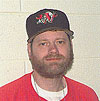| | Principal Investigators
| Steven P. Wise,
Ph.D. |
 |
|
Steven P. Wise graduated from Dartmouth College in 1974 and earned his Ph.D. degree from Washington
University in St. Louis three years later. After a brief postdoctoral stay at the Marine Biomedical Institute
in Galveston, Texas, he came to NIMH in 1978. He is currently the chief of the Section on
Neurophysiology in the Laboratory of Systems Neuroscience at the NIMH. His graduate and postdoctoral
work focused on the anatomical organization of the somatosensory cortex. Since coming to NIMH, Dr.
Wise and his colleagues have used the methods of behavioral neurophysiology to study the functional
organization of the frontal cortex, with particular emphasis on the premotor cortex and, more recently,
on the prefrontal cortex.
|
| Research
Interests |
Dr. Wise's group studies the neurobiology of conditional motor learning, which epitomizes the behavioral flexibility that characterizes our interactions with a rapidly changing, yet partially predictable environment (Brasted & Wise, 2004). Conditional motor learning differs importantly from traditional motor learning. To understand this difference, imagine reaching to a door knob. You automatically transform the relevant visuospatial information into a motor program that moves your hand toward the knob and begins the required prehension movements. These actions are based on traditional motor learning. Imagine now that you are in a strange building in which red rooms require that door knobs be twisted clockwise, but blue rooms require a counterclockwise twist. To open the doors, you would need to map the color information arbitrarily onto the necessary actions. That requires conditional motor learning, and symbolically guided behavior of all kinds depends on it.
Other research in the lab aims at distinguishing motor, attentional, and
mnemonic signals in the prefrontal cortex (PF).� They recorded from individual
neurons in the PF cortex that were trained to remember one location while
attending to another location (Lebedev et al., 2004). They found that the
activity of some of the recorded neurons depended on which location was being
remembered, but many more cells had activity that varied with the focus of
attention. This result indicates that PF cortex may be more important for
monitoring or deploying attentional resources than for maintaining a location in
working memory.
A monograph with Reza Shadmehr presents a theory of motor learning (Shadmehr
& Wise, 2005); a review of issues concerning so-called memory systems
suggests a new way of thinking about the medial temporal lobe (Murray &
Wise, 2004); and a review of plasticity in sensory vs. motor areas shows that
they have much in common at the algorithmic level (Paz et al., 2004).
|
| Representative Selected Recent Publications: |
- Shadmehr, R. and Wise, S.P.
The Computational Neurobiology of Reaching and Pointing: A Foundation for Motor Learning,
MIT Press xviii, +575pp, 2005.
- Lebedev, M.A., Messinger, A., Kralik, J.D., and Wise, S.P.
Representation of attended versus remembered locations in prefrontal cortex,
PLoS Biology, 2: 19197-1935, 2004.
- Murray, E.A. and Wise, S.P.
What, if anything, is the medial temporal lobe, and how can the amygdala be part of it if there is
no such thing? Neurobiology of Learning and Memory, 82: 178-198, 2004.
- Paz, R., Wise, S.P., and Vaadia, E.
Viewing and doing: Similar cortical mechanisms for perceptual and motor learning,
Trends in Neuroscience, 27: 496-503, 2004.
- Brasted, P.J. and Wise, S.P.:
Comparison of learning-related neuronal activity in the dorsal premotor cortex and striatum,
European Journal of Neuroscience, 19: 721-740, 2004.
|
Address:
|
SN LSN NIMH
49 Convent Drive
Bldg. 49 Rm. B1EE17 MSC 4401
Bethesda, MD 20892-4401 |
| Phone: |
301-402-5481 |
| Email Dr. Wise |
| Fax: |
301-402-5441 |
| Lab Web Site: |
No Web Site Available |
| |
|
|
|
|
